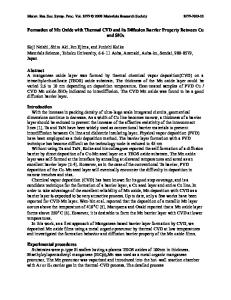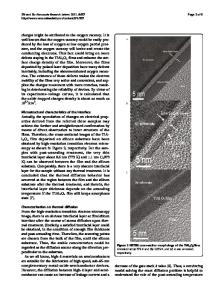Diffusion process in BaSi 2 film formation by thermal evaporation and its relation to electrical properties
- PDF / 946,970 Bytes
- 9 Pages / 584.957 x 782.986 pts Page_size
- 9 Downloads / 287 Views
Downloaded from https://www.cambridge.org/core. Tufts Univ, on 05 Jul 2018 at 11:27:44, subject to the Cambridge Core terms of use, available at https://www.cambridge.org/core/terms. https://doi.org/10.1557/jmr.2018.181
Diffusion process in BaSi2 film formation by thermal evaporation and its relation to electrical properties Kosuke O. Haraa) and Keisuke Arimoto Center for Crystal Science and Technology, University of Yamanashi, Kofu, Yamanashi 400-8511, Japan
Junji Yamanaka Center for Instrumental Analysis, University of Yamanashi, Kofu, Yamanashi 400-8510, Japan
Kiyokazu Nakagawa Center for Crystal Science and Technology, University of Yamanashi, Kofu, Yamanashi 400-8511, Japan (Received 11 April 2018; accepted 17 May 2018)
For fabricating photovoltaic BaSi2 films with controlled carrier density and suppressed oxidation by thermal evaporation, the mechanism determining the film composition from incongruently evaporated BaSi2 must be elucidated. We investigated the effects of source premelting, substrate temperature, and thickness on the structural and electrical properties of evaporated BaSi2 films. It is found by room-temperature deposition that the vapor composition continuously changes from being Ba-rich to being Si-rich. Source premelting suppresses the deposition of Ba-rich vapor. Deposition at 600–700 °C shows that BaSi2 forms through the mutual diffusion of Ba and Si, followed by surface oxidation by residual gas. Surface oxidation can be suppressed by a-axisoriented growth. By changing the film thickness, the optimum thickness to obtain homogeneous films with suppressed oxidation is revealed. Sufficient diffusion leads to high film resistivities and low electron densities, which demonstrates a close relationship between the film composition and the electrical properties.
I. INTRODUCTION
New absorber-layer materials with earth-abundant elements are desired for large-scale deployment of high-efficiency thin-film solar cells. BaSi2 is a promising candidate because of excellent optoelectronic properties and the abundance of constituent elements in the Earth’s crust.1 Its band gap is 1.3 eV, appropriate for solar cell applications.2–5 Optical absorption coefficients exceed 104 cm 1 for photon energies over Eg.2–4 Minority-carrier lifetime is long (.5 ls when surfacepassivated),6–9 and accordingly, minority-carrier diffusion length is long (10 lm).10,11 Majority carriers of undoped BaSi2 are usually electrons possibly because of intrinsic point defects.12,13 The conductivity type and carrier density can be controlled either by impurity doping14–21 or by controlling the Ba/Si ratio.13,22 Recently, solar cells with p-type BaSi2/n-type Si heterojunction has been realized by molecular beam epitaxy (MBE).23 The maximum power conversion efficiency is 9.9%.24 Thermal evaporation is currently the only method that can produce BaSi2 films with variable carrier density without using ultra high vacuum. The control of electron a)
Address all correspondence to this author. e-mail: [email protected] This paper has been selected a
Data Loading...










